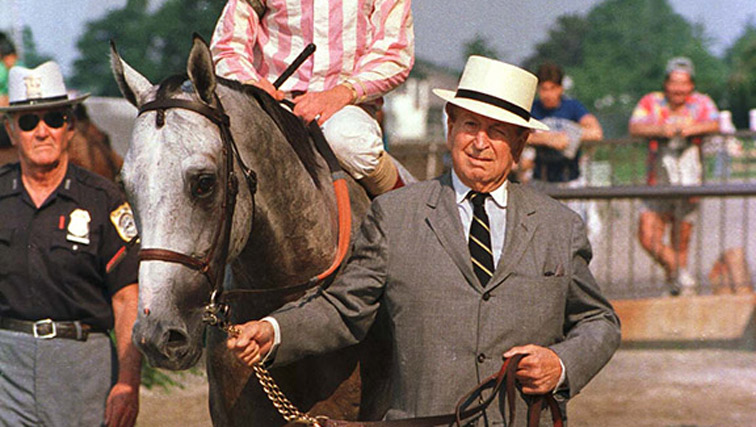Luro, Racing’s ‘Grand Senor,’ Succeeded with Style

Trainer Horation Luro leads one of his charges into the winner's circle. (All photos by Horsephotos.com)
By Tom Pedulla, America’s Best Racing
As part of a tribute to Horatio A. Luro following the death of the Hall of Fame trainer on Dec. 16, 1991, Joseph Durso wrote in The New York Times: “The style in Luro’s manner was obvious to all. He looked like Douglas Fairbanks Jr. and sounded like Maurice Chevalier, and he could sweep you off your feet with his wit and gallantry. He was the Grand Senor.”
Luro, who died at age 90, was a man befitting his “Grand Senor” moniker. He was someone who captured the imagination, for he worked hard and played hard, too. As the legendary trainer Charlie Whittingham, one of Luro’s protégés, told Durso, “You can’t be sad, because he gave it a great go.”
Luro was born into a wealthy family, allowing him the time and the opportunity to become passionate about polo and auto racing. When he was not indulging those interests, he built a reputation as quite the ladies’ man. He was often seen in the company of Hollywood stars such as Bing Crosby.
But there was substance to go with Luro’s style. He left his native Argentina for the United States with four horses and took it from there. He displayed such a keen understanding of breeding and training that he was enshrined in the Racing Hall of Fame in Saratoga Springs, N.Y., in 1980. He was elected to Canada’s Hall of Fame in 2014.
LURO ON HORSEBACK
He trained from 1937 to 1984 and produced 43 stakes winners, taking some of the most prestigious races in the U.S. and Canada. He saddled two Kentucky Derby winners. Decidedly, a California-bred, brought home the roses in 1962. He accomplished that with flair his trainer could appreciate by setting the Derby record with a time of 2:00 2/5 seconds for 1 ¼ miles.
Luro’s Northern Dancer would break that mark in the Derby two years later with a sizzling time of two minutes flat. Nothern Dancer went on to add the Preakness Stakes only to have his Triple Crown bid halted in the Belmont Stakes. There was no stopping him in the breeding shed, though, where he became a breed-shaping sire.
E. P. TAYLOR (left) AND LURO WITH NORTHERN DANCER
Luro made his mark north of the border as well. He won the Canadian International Stakes three times, with Eugenia II (1956), Spinney (1957) and One For All (1971). He matched that total in the prestigious Queen’s Plate, prevailing with Victoria Park (1960), Flaming Page (1962) and Northern Dancer, who staged a gallant rally from last in a memorable final start of his career.
Few could match Luro in his eye for a horse. He claimed Princequillo as an undersized 2-year-old for $2,500 in 1942, saying at the time, “Good horses come in all sizes, big and small.”
Princequillo developed into a powerful runner who captured the Jockey Club Gold Cup. He made an even greater mark after he was retired as the grandfather to the mighty Secretariat.
Luro once said of his career, “My family built a foundation in Argentina. And I trained Princequillo and Northern Dancer in America. Now, the whole world is buying from us.”
Durso summarized Luro’s career with these well-chosen words: “In a business that keeps trying to identify itself and its ‘product,’ Horatio Luro instinctively figured it all out. Horse racing isn’t just nine races a day, it’s a way of life. And he pursued it with style and gusto.”
Fun Facts
Was one of nine children.
Father, Adolfo, was a wealthy rancher and meat packer.
Three of Horatio’s uncles were founding members of the Argentine Jockey Club.
Was fluent in six languages, according to The New York Times.
Once engaged in a duel that he won when he nicked his opponent on the first lunge.
